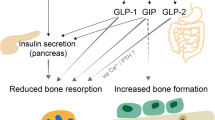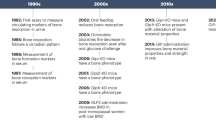Abstract
Postprandial variation of bone turnover markers and the closed relationship between bone remodeling and nutrient supply has been extensively studied in the past few years, but the underlying pathophysiologic mechanisms remain largely unknown. Recent studies have shown that the acute regulation of bone turnover induced by feeding is probably mediated by gastrointestinal (GI) peptides. The greater response of bone remodeling during oral versus intravenous glucose administration and the inhibition of this response after administration of octreotide, that inhibits the release of GI peptides, further support the existence of a gut-bone axis. Glucose-dependent insulinotropic peptide and glucagon-like peptides-1 and -2 are released from K and L cells of the gastrointestinal tract, respectively, and are considered the main mediators of the postprandial response of bone turnover. In this review we outline the most recent evidence that demonstrates the role of incretins in nutrient-dependent regulation of bone metabolism. Further elucidation of the underlying mechanisms can be exploited therapeutically in the future.
Article PDF
Similar content being viewed by others
Avoid common mistakes on your manuscript.
References
Rosenquist C, Fledelius C, Christgau S, et al, 1998 Serum CrossLaps One Step ELISA. First application of monoclonal antibodies for measurement in serum of bone-related degradation products from C-terminal telopeptides of type I collagen. Clin Chem 44: 2281–2289.
Rosenquist C, Qvist P, Bjarnason N, Christiansen C, 1995 Measurement of a more stable region of osteocalcin in serum by ELISA with two monoclonal antibodies. Clin Chem 41: 1439–1445.
Aoshima H, Kushida K, Takahashi M, et al, 1998 Circadian variation of urinary type I collagen crosslinked C-telopeptide and free and peptide-bound forms of pyridinium crosslinks. Bone 22: 73–78.
Gundberg CM, Markowitz ME, Mizruchi M, Rosen JF, 1985 Osteocalcin in human serum: a circadian rhythm. J Clin Endocrinol Metab 60: 736–739.
Greenspan SL, Dresner-Pollak R, Parker RA, Londo D, Ferguson L, 1997 Diurnal variation of bone mineral turnover in elderly men and women. Calcif Tissue Int 60: 419–423.
Gertz BJ, Clemens JD, Holland SD, Yuan W, Greenspan S, 1998 Application of a new serum assay for type I collagen cross-linked N-telopeptides: assessment of diurnal changes in bone turnover with and without alendronate treatment. Calcif Tissue Int 63: 102–106.
Hassanger C, Risteli J, Risteli L, Jensen SB, Christiansen C, 1992 Diurnal variation in serum markers of type I collagen synthesis and degradation in healthy premenopausal women. J Bone Miner Res 7: 1307–1311.
Heshmati HM, Riggs BL, Burritt MF, McAlister CA, Wollan PC, Khosla S, 1998 Effects of the circadian variation in serum cortisol on markers of bone turnover and calcium homeostasis in normal postmenopausal women. J Clin Endocrinol Metab 83: 751–756.
Ledger GA, Burritt MF, Kao PC, O’Fallon WM, Riggs BL, Khosla S, 1995 Role of parathyroid hormone in mediating nocturnal and age-related increases in bone resorption. J Clin Endocrinol Metab 80: 3304–3310.
Geoffriau M, Brun J, Chazot G, Claustrat B, 1998 The physiology and pharmacology of melatonin in humans. Horm Res 49: 136–141.
Ostrowska Z, Kos-Kudla B, Marek B, Swietochowska E, Gorski J, 2001 Assessment of the relationship between circadian variations of salivary melatonin levels and type I collagen metabolism in postmenopausal obese women. Neuro Endocrinol Lett. 22: 121–127.
Qvist P, Christgau S, Pedersen BJ, Schlemmer A, Christiansen C, 2002 Circadian variation in the serum concentration of C-terminal telopeptide of type I collagen (serum CTx): effects of gender, age, menopausal status, posture, daylight, serum cortisol, and fasting. Bone 31: 57–61.
Schlemmer A, Hassager C, 1999 Acute fasting diminishes the circadian rhythm of biochemical markers of bone resorption. Eur J Endocrinol 140: 332–337.
Henriksen DB, 2005 The gut feeling of bone remodeling IBMS BoneKEy 2: 16–15.
Clowes JA, Robinson RT, Heller SR, Eastell R, Blumsohn A, 2002 Acute changes of bone turnover and PTH induced by insulin and glucose: Euglycemic and hypoglycemic hyperinsulinemic clamp studies. J Clin Endocrinol Metab 87: 3324–3329.
Chailurkit LO, Chanprasertyothin S, Rajatanavin R, Ongphiphadhanakul B, 2008 Reduced attenuation of bone resorption after oral glucose in type 2 diabetes. Clin Endocrinol (Oxf) 68: 858–862.
Yavropoulou MP, Tomos K, Tsekmekidou X, et al, 2011 Response of biochemical markers of bone turnover to oral glucose load in diseases that affect bone metabolism. Eur J Endocrinol 164: 1035–1041.
Henriksen DB, Alexandersen P, Bjarnason NH, et al, 2003 Role of gastrointestinal hormones in postprandial reduction of bone resorption. J Bone Miner Res 18: 2180–2189.
Clowes JA, Allen HC, Prentis DM, Eastell R, Blumsohn A, 2003 Octreotide abolishes the acute decrease in bone turnover in response to oral glucose. J Clin Endocrinol Metab 88: 4867–4873.
Schmidt WE, 1997 The intestine, an endocrine organ. Digestion 58: 56–58.
Vilsboll T, Krarup T, Sonne J, et al, 2003 Incretin secretion in relation to meal size and body weight in healthy subjects and people with type 1 and type 2 diabetes mellitus. J Clin Endocrinol Metab 88: 2706–2713.
Brown JC, Dryburgh JR, 1971 A gastric inhibitory polypeptide. II. The complete amino acid sequence. Can J Biochem 49: 867–872.
Ding KH, Zhong Q, Xu J, Isales CM, 2004 Glucose-dependent insulinotropic peptide: differential effects on hepatic artery vs. portal vein endothelial cells. Am J Physiol Endocrinol Metab 286: E773–779.
Fehmann HC, Goke R, Goke B, 1995 Cell and molecular biology of the incretin hormones glucagon-like peptide-I and glucose-dependent insulin releasing polypeptide. Endocrine Reviews 16: 390–410.
Knapper JM, Morgan LM, Fletcher JM, 1996 Nutrient-induced secretion and metabolic effects of glucose-dependent insulinotropic polypeptide and glucagon-like peptide-1. Proc Nutr Soc 55: 291–305.
Kogire M, Inoue K, Sumi S, Doi R, Takaori K, Yun M, 1988 Effects of synthetic human gastric inhibitory polypeptide on splachnic circulation in dogs. Gastroenterology 95: 1636–1640.
Yip RG, Boylan MO, Kieffer TJ, Wolfe MM, 1998 Functional GIP receptors are present on adipocytes. Endocrinology 139: 4004–4007.
Usdin TB, Mezey E, Button DC, Brownstein MJ, Bonner TI, 1993 Gastric inhibitory polypeptide receptor, a member of the secretin-vasoactive intestinal peptide receptor family, is widely distributed in peripheral organs and the brain. Endocrinology 133: 2861–2870.
Kieffer TJ, Mcintosh CH, Pederson RA, 1995 Degradation of glucose-dependent insulinotropic polypeptide and truncated glucagon-like peptide 1 in vitro and in vivo by dipeptidyl peptidase IV Endocrinology 136: 3585–3596.
Xie D, Zhong Q, Ding KH, et al, 2007 Glucose-dependent insulinotropic peptide-overexpressing transgenic mice have increased bone mass. Bone 40: 1352–1360.
Xie D, Cheng H, Hamrick M, et al, 2005 Glucose-dependent insulinotropic polypeptide receptor knockout mice have altered bone turnover. Bone 37: 759–769.
Bollag RJ, Zhong Q, Phillips P, et al, 2000 Osteoblast-derived cells express functional glucose-dependent insulinotropic peptide receptors. Endocrinology 141: 1228–1235.
Pacheco-Pantoja EL, Ranganath LR, Gallagher JA, Wilson PJ, Fraser WD, 2011 Receptors and effects of gut hormones in three osteoblastic cell lines. BMC Physiol 11: 12.
Tsukiyama K, Yamada Y, Yamada C, et al 2006 Gastric inhibitory polypeptide as an endogenous factor promoting new bone formation after food ingestion. Molecular Endocrinology 20: 1644–1651.
Ding KH, Shi XM, Zhong Q, et al, 2008 Impact of glucose-dependent insulinotropic peptide on age-induced bone loss. J Bone Miner Res 23: 536–543.
Zhong Q, Itokawa T, Sridhar S, et al, 2007 Effects of glucose-dependent insulinotropic peptide on osteoclast function. Am J Physiol Endocrinol Metab 292: E543–548.
McIntosh CH, Wheeler MB, Gelling RW, Brown JC, Pederson RA, 1996 GIP receptors and signal-transduction mechanisms. Acta Physiol Scand 157: 361–365.
Stanley KT, Van Dort C, Motyl C, Endres J, Fox DA, 2006 Immunocompetent properties of human osteoblasts: interactions with T lymphocytes. J Bone Miner Res 21: 29–36.
McClean PL, Irwin N, Hunter K, Gault VA, Flatt PR, 2008 (Pro(3))GIP[mPEG]: novel, long-acting, mPEGylated antagonist of gastric inhibitory polypeptide for obesity-diabetes (diabesity) therapy. Br J Pharmacol 155: 690–701.
Parker JC, Irwin N, Lavery KS, et al, 2007 Metabolic effects of sub-chronic ablation of the incretin receptors by daily administration of (Pro3)GIP and exendin(9-39) amide in obese diabetic (ob/ob) mice. Biol Chem 388: 221–226.
Hinke SA, Gelling RW, Pederson RA, et al, 2002 Dipeptidyl peptidase IV-resistant [D-Ala(2)] glucose-dependent insulinotropic polypeptide (GIP) improves glucose tolerance in normal and obese diabetic rats. Diabetes 51: 652–661.
Creutzfeldt W, 2005 The [pre-] history of the incretin concept. Regulatory Peptides 128: 87–91.
Baggio LL, Drucker DJ, 2007 Biology of incretins: GLP-1and GLP-2. Gastrenterology 132: 2131–2157.
Baggio LL, Drucker DJ, 2004 Clinical endocrinology and metabolism. GLP-1 and GLP-2. Best Pract Res Clin Endocrinol Metab 18: 531–534.
Yamada C, Yamada Y, Tsukiyama K, et al, 2008 The murine glucagonlike peptide-1 receptor is essential for control of bone resorption. Endocrinology 149: 574–579.
Lamari Y, Boissard C, Moukhtar MS, Jullienne A, Rosselin G, Garel JM, 1996 Expression of glucagon-like peptide 1 receptor in a murine C cell line: regulation of calcitonin gene by glucagon-like peptide 1. FEBS Lett 393: 248–252.
Crespel A, De Boisvilliers F, Gros L, Kervran A, 1996 Effects of glucagon and glucagon-like peptide-1-(7–36) amide on C cells from rat thyroid and medullary thyroid carcinoma CA-77 cell line. Endocrinology 137: 3674–3680.
Nuche-Berenguer B, Moreno P, Esbrit P, et al, 2009 Effect of GLP-1 treatment on bone turnover in normal, type 2 diabetic, and insulin-resistant states. Calcif Tissue Int 84: 453–461.
Nuche-Berenguer B, Moreno P, Portal-Nuñez S, et al, 2010 Exendin-4 exerts osteogenic actions in insulin-resistant and type 2 diabetic states. Regul Pept 159: 61–66.
Nuche-Berenguer B, Lozano D, Gutiérrez-Rojas I, et al, 2011 GLP-1 and exendin-4 can reverse hyperlipidic-related osteopenia. J Endocrinol 209: 203–210.
Sanz C, Vázquez P, Blázquez C, Barrio PA, Alvarez M del M, Blaïzquez E, 2010 Signaling and biological effects of glucagon-like peptide 1 on the differentiation of mesenchymal stem cells from human bone marrow. Am J Physiol Endocrinol Metab 298: E634–E643.
Nuche-Berenguer B, Portal-Nunez S, Moreno P, et al, 2010 Presence of a functional receptor for GLP-1 in osteoblastic cells, independent of the cAMP-linked GLP-1 receptor. J Cell Physiol 225: 585–592.
Villanueva-Peñacarrillo ML, Delgado E, Trapote MA, et al, 1995 Glucagon-like peptide-1 binding to rat hepatic membranes. J Endocrinol 146: 183–189.
Bunck MC, Eliasson B, Corner A, et al, 2011 Exenatide treatment did not affect bone mineral density despite body weight reduction in patients with type 2 diabetes. Diabetes Obes Metab 13: 374–377.
Riedt CS, Cifuentes M, Stahl T, Chowdhury HA, Schlussel Y, Shapses SA, 2005 Overweight postmenopausal women lose bone with moderate weight reduction and 1 g/day calcium intake. J Bone Miner Res 20: 455–463.
Blonde L, Klein EJ, Han J, et al, 2006 Interim analysis of the effects of exenatide treatment on A1C, weight and cardiovascular risk factors over 82 weeks in 314 overweight patients with type 2 diabetes. Diabetes Obes Metab 8: 436–447.
Estall JL, Drucker DJ, 2006 Glucagon-like Peptide-2. Annu Rev Nutr. 26: 391–411.
Henriksen DB, Alexandersen P, Byrjalsen I, et al, 2004 Reduction of nocturnal rise in bone resorption by subcutaneous GLP-2. Bone 34: 140–147.
Henriksen DB, Alexandersen P, Hartmann B, et al, 2007 Disassociation of bone resorption and formation by GLP-2: a 14-day study in healthy postmenopausal women. Bone 40: 723–729.
Henriksen DB, Alexandersen P, Hartmann B, et al, 2009 Four-month treatment with GLP-2 significantly increases hip BMD: a randomized, placebo-controlled, dose-ranging study in postmenopausal women with low BMD. Bone 45: 833–842.
Askov-Hansen C, Jeppesen PB, Lund P, Hartmann B, Holst JJ, Henriksen DB, 2013 Effect of glucagon-like peptide-2 exposure on bone resorption: Effectiveness of high concentration versus prolonged exposure. Regul Pept 181: 4–8.
Nørholk LM, Holst JJ, Jeppesen PB, 2012 Treatment of adult short bowel syndrome patients with teduglutide. Expert Opin Pharmacother 13: 235–243.
Monami M, Dicembrini I, Antenore A, Mannucci E, 2011 Dipeptidyl peptidase-4 inhibitors and bone fractures: a meta-analysis of randomized clinical trials. Diabetes Care 34: 2474–2476.
Author information
Authors and Affiliations
Corresponding author
Rights and permissions
About this article
Cite this article
Yavropoulou, M.P., Yovos, J.G. Incretins and bone: Evolving concepts in nutrient-dependent regulation of bone turnover. Hormones 12, 214–223 (2013). https://doi.org/10.14310/horm.2002.1405
Received:
Accepted:
Published:
Issue Date:
DOI: https://doi.org/10.14310/horm.2002.1405




